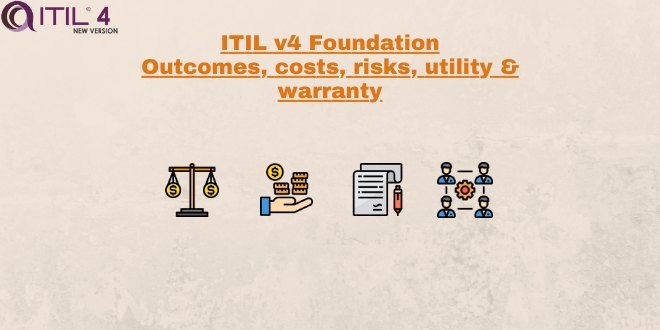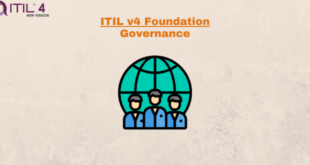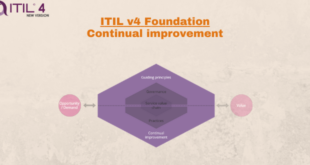Contents
A service provider should always evaluate their services to create an outcome which meets the needs of their service consumer – There is no point building a service that isn’t fit for use or doesn’t meet the consumers performance expectations. The service provider must also evaluate if the desired outcome of a service creates value after considering a balance amount of associated costs and risks between the provider and consumer.
Achieving desired outcomes requires resources (and therefore costs) and is often associated with risks. Service providers help their consumers to achieve outcomes, and in doing so, take on some of the associated risks and costs.
(Maybe it’s not the best idea to start selling bags of ice to people in the arctic… although… low transport costs 🙂 )
Outcomes
A service relationship is perceived as valuable to a service consumer only when they have more positive effects than negative. The costs and risks removed from the consumer are part of the overall value proposition considered by the service consumer.
[Real estate example] Our organization has created a service offering to help purchase and sell property – Brokers and the rest of our team will ensure that all of the required documents are managed when purchasing a property (output). For the customer, the outcome will be a smooth acquisition where everything has been taken care by a professional, removing certain risks associated if done without the service.
Costs
The amount of money spent on a specific activity or resource.
A service consumer will weigh up both types of costs to asses if the value proposition makes sense. This is just as important for a service provider, who must fully understand the costs of the services being provisioned to meet the organizations exceptions.
Costs removed from the consumer
By using a service provider and their service(s), what costs are being saved for the consumer through using that organizations resources.
[Real estate example] When a client is selling a property, they don’t want to manage all the viewings, negotiations and ensuring documents are correctly prepared. It is much easier to simply have someone else manage this process as we simply don’t have the time and resources to manage this whole process.
Costs imposed on the consumer
By using a service provider and their service(s), what costs are imposed on the consumer through using that organizations resources.
[Real estate example] We know that using a real estate brokers services will end up costing us a certain amount in final commission when the property sells. Considering all the work that goes into selling and our lacking knowledge of the process, it makes sense for us to use a broker rather than trying to do it ourselves.
Risks
A possible event that could cause harm or loss, or make it more difficult to achieve objectives. Can also be defined as uncertainty of outcome, and can be used in the context of measuring the probability of positive outcomes as well as negative outcomes.
It is the responsibility to of the service provider to manage the detailed level of risk on behalf of the service consumer. This should be handled based on a balance of what matters most to the consumer and to the provider.
[Real estate example] Our brokers are at times working with too many clients which is slowing the overall performance of the service and at times creating a large risk for consumers trying to reach an outcome. This is a risk that can be reduced by the service provider setting a maximum number of active clients each broker can work at any given time. This ensures that the risk of overloaded brokers is reduced and does not impact any single consumer outcome when using the providers services.
The consumer will also contribute to the reduction of risk through:
- Active participation in defining the requirement of the service and the desired outcome.
- Communicating crucial success factors (CSFs) and constraints that apply to the service.
- Ensuring the provider has access to the necessary resources via the service relationship to reach the desired outcome.
Risks removed from the consumer
By using a service provider and their service(s), what risk(s) are being removed from the consumer and taken on by the organization.
[Real estate example] Our service consumers need someone who understands the local market in a great amount of depth. This is knowledge and expertise which takes years to acquire. There also appears to be a lot of legal documents and regulations around certain property purchases which can become costly if done wrong. By offering this as a service we will remove the risk from our consumers.
Risks imposed on the consumer
By using a service provider and their service(s), what risk(s) are potentially being introduced to the consumer by using the organizations resources.
[Real estate example] There is the possibility that the broker isn’t well seasoned and ends up miss-managing the process costing the consumer money and delaying the purchase or sale process. (this is where the consumer must consider warranty). There is also the risk that our broker simply isn’t aware of changing market conditions and makes poor choices leading to a negative outcome.
Utility & Warranty
In order to evaluate whether a service or service offering will facilitate the desired outcome, the utility and warranty of the service should be assessed. This assessment takes into consideration the costs and risks of using the service to give a full picture on the viability of the service.
Utility
‘What does it do’ and is it ‘fit for purpose’
[Real estate example] Our brokerage service has well trained brokers who can help in all aspects of purchasing or selling a property, including, evaluating the market, attending visits and managing any documents needed throughout the whole process. This service is ‘fit for purpose’ if you are considering buying or selling real estate.
Warranty
‘How does it perform’ and ‘is it fit for use’
[Real estate example] To help reassure customers that our service is always reliable, we have multiple brokers working on one file at any given time to ensure high availability if problems arise. This great level of service has also been validated by many past clients who have given raving review about the amazing service we provide throughout the purchase and sale process. All contracts are non-binding, so if a consumer isn’t happy, they can cancel their agreement at any time without inuring costs.
 MooMetric.com Integrating marketing and business metrics using code and non code solutions.
MooMetric.com Integrating marketing and business metrics using code and non code solutions.







